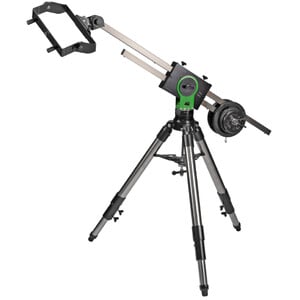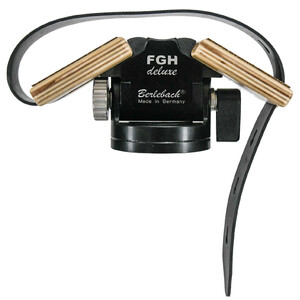Of course, binoculars for astronomy must first have a certain aperture. Binoculars with an exit pupil under 4mm are only of limited suitability. The magnification is dependent upon the object of your observing. Binoculars with low magnification are very well-suited to getting an overview of the starry sky or for looking for constellations.
To see details on the moon or the planets, the magnification should be at least 10 times or higher. Many customers prefer binoculars with single-ocular focus, because once set for personal visual acuity, no further sharpness correction is needed. Very often, customers use porro prism binoculars because they provide a more plastic image.

Bresser
Mount Slider
$ 1,180.00

Bresser
Mount Slider
$ 940.00

Berlebach
Mount FGH deluxe binocular holder
$ 293.00
What is important when selecting binoculars for astronomy?
What criteria must be met?
The "very good" rating for binoculars is achieved if they meet the following:
- The magnification should be at least 10 times so that you can also see details of the sky canopy.
- A front lens diameter of 70 mm is required.
- The exit pupil must not be less than 5 mm in diameter.
- Other evaluation criteria: since temperatures often fall sharply at night, the binoculars should be watertight. This prevents the ingress of humidity, which would otherwise cause fogging inside the binoculars if the temperature drops suddenly. A tripod is absolutely necessary for overhead observing and with higher magnification levels, therefore a tripod attachment should be included.
- We consider the size of the field of view or the weight to be unimportant for astronomy.
- Positive influencing factors:
Special lens materials (FL, ED, HD) or lens construction (APO, field flattener) increase the rating. These ensure that binoculars that would have otherwise only reached a "good” are rated "very good”. - Negative influencing factors:
Information displayed in the field of view such as a compass, a reticle or an integrated distance meter, affects the view and causes the binoculars to be downgraded by a point.
For a "good", binoculars must achieve the following:
- Magnification: min. 7-times
- Front lens diameter: min. 50 mm
- Exit pupil: min. 4.5 mm
- Tripod attachment: should be available, but there are also solutions for this if necessary.
For a "medium" we will accept:
- Magnification: min. 7-times
- Front lens diameter: min. 40 mm
- Exit pupil: min. 4 mm
We rate binoculars with too little magnification or with an exit pupil of less than 4 mm as "not recommended" for astronomy.
Exceptions are, of course, special binoculars such as the Omegon 2.1x42 for star field observing.
